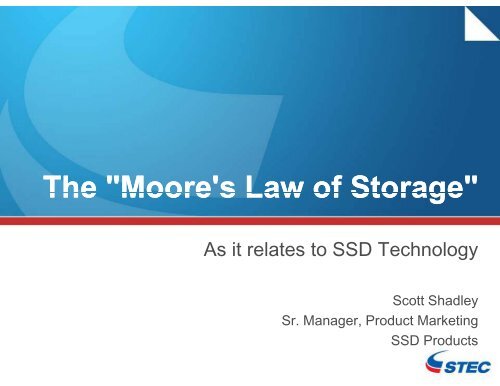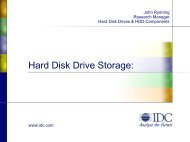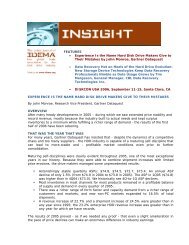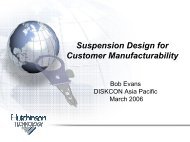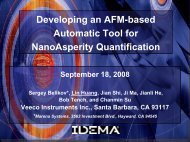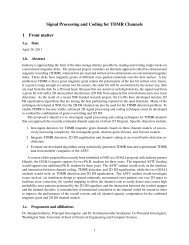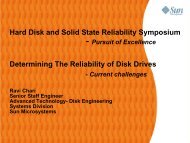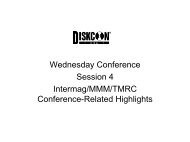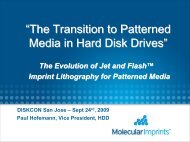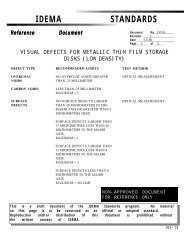The "Moore's Law of Storage" The Moore s Law of Storage - IDEMA
The "Moore's Law of Storage" The Moore s Law of Storage - IDEMA
The "Moore's Law of Storage" The Moore s Law of Storage - IDEMA
Create successful ePaper yourself
Turn your PDF publications into a flip-book with our unique Google optimized e-Paper software.
<strong>The</strong> "<strong><strong>Moore</strong>'s</strong> <strong>Law</strong> <strong>of</strong> <strong>Storage</strong>"As it relates to SSD TechnologyScott ShadleySr. Manager, Product MarketingSSD Products
Agenda• HDD and <strong>Moore</strong>’s <strong>Law</strong>• Capacity versus Need• Illustrating the SSD window• NAND and <strong>Moore</strong>’s <strong>Law</strong>• Beating the curve and benefit the User• <strong>The</strong> Technology Applied• How to compete for the space• How big is your Hemi?• What’s next in SSD technology?• <strong>The</strong> next best technology• Aggressive Roadmaps2Presented at <strong>IDEMA</strong> Symposium – 11 DEC 2008
HDD, <strong>Moore</strong>’s <strong>Law</strong>, and the real NeedCapacity increases are creating unused space, while not significantlyimproving user needs for performance3Presented at <strong>IDEMA</strong> Symposium – 11 DEC 2008
NAND is “skipping along”Node (nm)Capacity (Gb)9016604130200520062007NAND technology transition create great advantages for Users<strong>The</strong>se same transitions create new challenges for enablersProper planning, understanding, and knowledge are keys200820094
<strong>The</strong> Technology AppliedWhat it takes to make the SSD work
Distinct Product Requirements<strong>Storage</strong> Arrays and ServersNotebooks/DesktopsUltra Mobile PCENTERPRISE (Tier 0 Performance)10,000 to 45,000 IOPSENTERPRISE5,000 to 10,000 IOPSCLIENT< 5,000 IOPSULTRA SMALL FORM FACTORSweet SpotUltra-High End ServersTransfer Rate in MB/s secSweet SpotLow-End Servers (boot device)Sweet SpotSweet SpotSOLUTION:SOLUTION :SOLUTION :SOLUTION:High-end Enterprise- High-end Enterprise- High ReliabilityCost-Effective yetClass SSDClass SSDNotebook-Class SSD Reliable UM-SSD(IF = FC and SAS) S)(IF = SAS) S)(IF = SATA) (IF = SATA)Fundamentally Different Product Architectures Underlie Each Variation7Presented at <strong>IDEMA</strong> Symposium – 11 DEC 2008
Look Ahead:Architectural DevelopmentsSolving the Capacity PerformanceDilema
"...<strong>The</strong>re will be increasingscaling problems forNAND...which becomes seriousat the 65nm node."9
Innovations in the MediaEver evolving roadmap critical media changes, continue tomake progress faster than anticipated2008 2010• 30 nm NAND node2009 2010• 3-bit per cell2010 2012• 4-bit per cell2012 2015 • PCM viable memory10Presented at <strong>IDEMA</strong> Symposium – 11 DEC 2008
Smaller FF larger ValueWhile exceeding <strong>Moore</strong>’s law, NAND is driving capacity up exponentiallyMeanwhile the adoption <strong>of</strong> the NetBook is driving the need for smaller FFWhat makes the overall best solution?Notebook market in 2008 had a maximum SSD capacity <strong>of</strong> 128GBNetbook market demands are driving for a up to 64GB SSD11Presented at <strong>IDEMA</strong> Symposium – 11 DEC 2008
Smaller FF larger ValueHow do you move from an HDD FF and capacity to an SSD for a netbook?12Presented at <strong>IDEMA</strong> Symposium – 11 DEC 2008
Closing thoughts on what is next• Next-generation media technologies enable newusage models <strong>of</strong> memory within the SSD• PCM, FeRAM, MRAM, 3D?• All are potentially viable solutions• All provide significant integration challenges• FW, Controller, Data Management.13Presented at <strong>IDEMA</strong> Symposium – 11 DEC 2008


